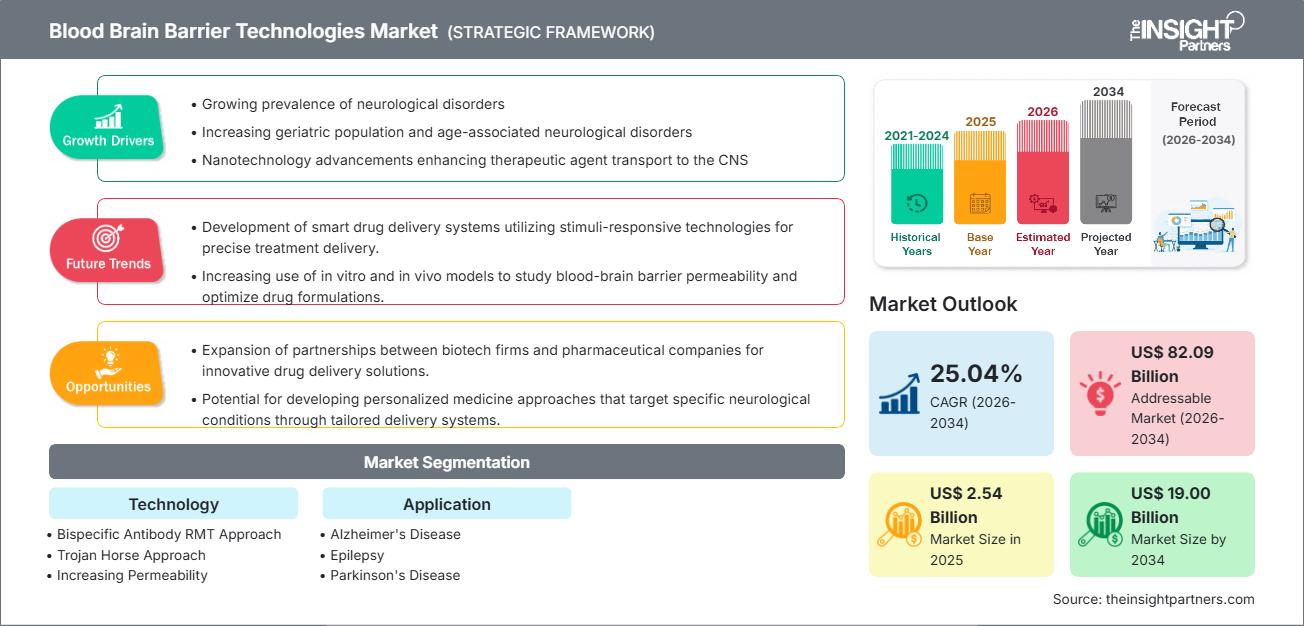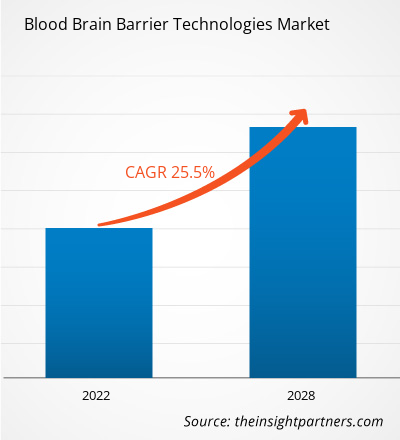혈뇌장벽(BBB) 기술 시장 규모는 2025년 25억 4천만 달러에서 2034년 190억 달러에 이를 것으로 예상됩니다. 이 시장은 2026년부터 2034년까지 예측 기간 동안 25.04%의 높은 연평균 성장률(CAGR)을 기록할 것으로 전망됩니다.
혈뇌 장벽 기술 시장 분석
혈뇌장벽(BBB) 기술 시장은 전 세계적으로 증가하는 신경계 질환 유병률과 중추신경계(CNS)에 효과적인 치료제를 전달하는 데 따르는 지속적인 어려움에 힘입어 폭발적인 성장을 보일 것으로 전망됩니다. 이러한 시장 확장은 주요 제약 및 생명공학 기업들의 신경과학 연구 개발에 대한 대규모 전략적 투자에 힘입은 바가 큽니다. 이들 기업은 BBB의 자연적인 보호 메커니즘을 극복하기 위해 수용체 매개 세포횡단수송(RMT) 및 표적 나노입자와 같은 혁신적인 약물 전달 플랫폼을 빠르게 도입하고 있습니다. 또한, 규제 기관들이 새로운 CNS 질환 치료제에 대해 신속 심사 제도를 도입하면서 표적 약물 침투를 위한 신기술 개발 및 상용화가 가속화되고 있습니다.
혈뇌 장벽 기술 시장 개요
혈뇌장벽 기술은 약물이 뇌와 척수에 접근하는 것을 제한하는 고도로 선택적인 내피 장벽을 일시적으로 조절하거나 우회하도록 특별히 설계된 정교한 방법과 시스템을 포괄합니다. 이 시장에는 내인성 수송 경로를 활용하는 이중특이항체 및 트로이 목마 벡터와 같은 생물학적 접근법뿐만 아니라 투과성을 향상시키는 집중 초음파(FUS) 및 삼투압 파괴와 같은 물리적 방법도 포함됩니다. 이러한 기술은 항체 및 펩타이드와 같은 대분자 생물학적 제제 및 일반적으로 중추신경계 질환에 효과적이지 않은 기타 약물의 치료 잠재력을 발휘하는 데 매우 중요합니다. 뇌 실질 내 약물 농도를 정확하고 높게 유지함으로써, 이러한 기술은 만성 신경 질환 치료의 패러다임을 혁신적으로 변화시킬 것으로 기대됩니다.
이 보고서를 귀하의 요구사항에 맞게 맞춤 설정하십시오.
모든 보고서에 대한 맞춤형 서비스(본 보고서의 일부 또는 국가별 분석, Excel 데이터 팩 포함)를 무료로 제공해 드립니다. 또한 스타트업 및 대학을 위한 다양한 할인 혜택도 누리실 수 있습니다.
혈뇌장벽 기술 시장: 전략적 고찰

-
이 보고서에서 주요 시장 동향을 확인하세요.이 무료 샘플에는 시장 동향부터 추정치 및 예측에 이르기까지 다양한 데이터 분석이 포함됩니다.
혈뇌장벽 기술 시장 동인 및 기회
시장 동인:
- 신경계 질환 유병률 증가 및 충족되지 않은 높은 수요: 알츠하이머병, 파킨슨병, 다발성 경화증을 포함한 신경퇴행성 질환의 전 세계적인 발병률 증가는 이러한 질환을 치료할 수 있는 혁신적인 약물 전달 시스템에 대한 시급하고 가치 있는 수요를 창출하고 있습니다. 이러한 질환들은 과거에는 혈뇌장벽(BBB) 문제로 인해 제대로 치료받지 못했습니다.
- 중추신경계 표적 약물 전달에 대한 수요 증가: 현대 제약 연구 개발은 높은 특이성과 낮은 독성을 지닌 치료제 개발에 집중하고 있습니다. 혈뇌장벽(BBB) 기술은 이러한 약물을 표적 부위에 전달하여 전신 노출과 잠재적인 부작용을 최소화하는 동시에 질병 부위에서의 치료 농도를 극대화할 수 있도록 합니다.
- 생명공학 및 제약 연구개발 투자 증가: 연구개발 자본이 신경과학 분야로 뚜렷하게 이동하고 있습니다. 정부와 사모펀드는 대형 제약회사들의 중추신경계 약물 파이프라인 위험을 줄여주는 독자적인 혈뇌장벽(BBB) 플랫폼 개발에 전념하는 전문 생명공학 기업에 막대한 자금을 지원하고 있습니다.
시장 기회:
- 환자 순응도 향상을 위한 비침습적 혈뇌장벽(BBB) 기술 개발: 집중 초음파(FUS)와 같은 기술은 비침습적으로 혈뇌장벽을 일시적이고 정확하게 개방할 수 있어 중요한 가능성을 제시합니다. FUS는 특히 수술이나 뇌실내 투여 방식과 비교했을 때, 환자 순응도를 향상시키고 반복 투여를 가능하게 할 것으로 기대됩니다.
- 의료 인프라가 발전하는 신흥 시장으로의 확장: 아시아 태평양 및 라틴 아메리카 지역의 경제가 성숙해짐에 따라 전문 의료 서비스에 대한 투자와 첨단 생물학적 제제에 대한 접근성이 증가하고 있습니다. 이는 특히 의료 서비스 혜택을 제대로 받지 못하는 환자 집단이 많은 지역에서 BBB 플랫폼을 위한 새로운 시장을 열어줍니다.
- 임상시험 및 상용화 가속화를 위한 전략적 파트너십: 혁신적인 BBB 플랫폼을 보유한 바이오테크 기업과 광범위한 임상 파이프라인 및 상용화 규모를 갖춘 다국적 제약 회사 간의 협력이 매우 중요합니다. 라이선스 계약 및 합작 투자를 통해 BBB 기반 약물의 임상시험 및 시장 진출을 가속화할 수 있습니다.
혈뇌장벽 기술 시장 보고서 세분화 분석
혈뇌장벽 기술 시장은 약물 전달을 촉진하는 데 사용되는 핵심 메커니즘과 목표로 하는 특정 질병 영역을 기준으로 세분화됩니다.
기술별 분류:
- 이중특이항체 수용체 매개 세포횡단수송(RMT) 접근법
- 트로이 목마식 접근법
- 투과성 증가
- 수동 확산
- 기타 비침습적 BBB 기술
신청을 통해:
- 알츠하이머병(AD)
지리학별:
- 북아메리카
- 유럽
- 아시아 태평양
- 남미 및 중앙아메리카
- 중동 및 아프리카
혈뇌장벽 기술 시장 지역별 분석
인사이트 파트너스의 분석가들은 예측 기간 동안 혈뇌 장벽 기술 시장에 영향을 미치는 지역별 동향과 요인을 자세히 설명했습니다. 이 섹션에서는 북미, 유럽, 아시아 태평양, 중동 및 아프리카, 남미 및 중앙아메리카를 아우르는 혈뇌 장벽 기술 시장 세분화 및 지역별 분석도 다룹니다.
혈뇌장벽 기술 시장 보고서 범위
| 보고서 속성 | 세부 |
|---|---|
| 2025년 시장 규모 | 25억 4천만 달러 |
| 2034년 시장 규모 | 미화 190억 달러 |
| 글로벌 연평균 성장률(2026년~2034년) | 25.04% |
| 역사적 데이터 | 2021-2024 |
| 예측 기간 | 2026-2034 |
| 포함되는 부문 |
기술에 의해
|
| 대상 지역 및 국가 |
북아메리카
|
| 시장 선도 기업 및 주요 기업 프로필 |
|
혈뇌장벽 기술 시장 참여자 밀도: 비즈니스 역학에 미치는 영향 이해
혈뇌장벽 기술 시장은 소비자 선호도 변화, 기술 발전, 제품 효능에 대한 인식 제고 등 여러 요인으로 인해 최종 사용자 수요가 증가하면서 빠르게 성장하고 있습니다. 수요가 증가함에 따라 기업들은 제품군을 확장하고, 소비자 요구를 충족하기 위한 혁신을 추진하며, 새로운 트렌드를 활용하여 시장 성장을 더욱 촉진하고 있습니다.

- 혈뇌 장벽 기술 시장의 주요 기업 개요를 확인하세요.
혈뇌 장벽 기술 시장 점유율 분석 (지역별)
북미 지역이 가장 큰 시장 점유율을 차지하고 있으며, 아시아 태평양 지역은 예측 기간 동안 가장 빠른 성장률을 보일 것으로 예상됩니다. 이러한 세계적 시장 지배력은 주로 지역별 연구 개발 집중도, 지적 재산권, 그리고 고위험 고수익 중추신경계 치료법에 유리한 규제 환경에 의해 형성됩니다. 아래는 지역별 시장 점유율 및 동향 요약입니다.
북아메리카
- 시장 점유율: 혈뇌 장벽 기술 시장을 장악하고 있으며, 주요 제약 회사들의 집중도, 방대한 연구 개발 인프라, 그리고 혈뇌 장벽 플랫폼 전문 바이오테크 스타트업에 대한 상당한 벤처 캐피털 자금 지원을 통해 최대 점유율을 차지하고 있습니다.
- 주요 성장 동력: 알츠하이머병 및 파킨슨병 치료제 개발의 활발한 진행.
- 동향: 첨단 RMT 및 이중특이항체 기술의 임상 적용을 통한 후기 임상시험에 대한 강력한 강조가 나타나고 있습니다.
유럽
- 시장 점유율: 정부 지원 연구 사업(예: 신경과학 분야에 대한 호라이즌 유럽 기금)과 지역 전반에 걸쳐 증가하는 중추신경계 질환 부담에 힘입어 상당한 시장 점유율을 차지하고 있습니다.
- 주요 동력: 기관과 산업 파트너 간의 강력한 학술적 협력.
- 동향: 유럽 연구 병원에서 시험 중인 비침습적 물리적 혈뇌장벽 조절 기술, 특히 집중 초음파 기술의 도입이 증가하고 있습니다.
아시아태평양
- 시장 점유율: 의료 연구에 대한 투자 급증, 신경 질환 환자 수 증가, 그리고 전문 생명공학 허브 설립으로 인해 가장 빠르게 성장하는 지역입니다.
- 주요 동인: 초기 단계의 BBB 혁신에 집중하는 민간 생명공학 기업의 급속한 성장.
- 동향: 현지 바이오테크 기업이 서구 제약 회사와 협력하여 지역 시장에 맞춘 BBB(혈뇌장벽) 치료제를 공동 개발하는 파트너십 모델이 많이 채택되고 있습니다.
남미와 중앙아메리카
- 시장 점유율: 제약 부문의 확장과 전문 의료 서비스 접근성 향상에 힘입어 성장 잠재력이 큰 신흥 시장입니다.
- 주요 동인: 신경계 건강 불균형 해소를 목표로 하는 공공-민간 의료 파트너십.
- 동향: 비용 효율적인 트로이 목마 전략의 초기 도입 및 수동 확산 촉진제를 활용한 제네릭 의약품 용도 변경.
중동 및 아프리카
- 시장 점유율: 정부의 의료 인프라 확장 투자와 의료 연구 개발 센터 설립에 대한 집중적인 노력에 힘입어 성장 잠재력이 높은 개발 도상 시장입니다.
- 주요 동인: 신경과를 포함한 전문 진료를 우선시하는 국가 전자 의료 전략.
- 동향: 최첨단 BBB 기술에 대한 접근이 필요한 전문 신경과학 연구 프로그램의 시행이 주로 세계적인 선도 기업과의 협력을 통해 이루어지고 있습니다.
혈뇌장벽 기술 시장 참여자 밀도: 비즈니스 역학에 미치는 영향 이해
혈뇌장벽 기술 시장의 경쟁 환경은 매우 역동적이며, 대형 제약 회사와 소규모 전문 바이오 기술 플랫폼 개발 업체들이 혼재되어 있습니다. 경쟁은 최종 의약품의 상용화뿐만 아니라, 자사 고유의 약물 전달 기술 자체의 우수한 안전성, 효능 및 확장성을 입증하는 데 집중되어 있습니다.
이러한 경쟁 환경으로 인해 공급업체는 다음과 같은 방식으로 차별화를 꾀하게 됩니다.
- 검증된 전달 플랫폼: 초기 임상 시험(1상 및 2상)에서 BBB 기술의 임상적 안전성과 효능을 입증하는 것이 주요 경쟁 우위입니다.
- 전략적 라이선싱 및 파트너십: 소규모 바이오테크 기업들은 자체 개발한 BBB 기술을 대형 제약회사에 라이선스하여 개발 자금을 확보하고 광범위한 시장 진출을 보장하는 데 집중합니다.
- 특정 수용체 표적화: 표적 외 효과를 최소화하고 신규 또는 활용도가 낮은 혈뇌장벽(BBB) 수용체를 통해 뇌 흡수율을 극대화하는 차세대 이중특이성 항체 개발.
- 비침습적 치료법 통합: 물리적 파괴 기술(예: 초음파 유도 치료)과 특정 약물 후보 물질을 통합하여 완전한 비수술적 치료 솔루션을 제공하는 데 중점을 둡니다.
혈뇌장벽 기술 시장에서 활동하는 주요 기업은 다음과 같습니다.
- 테바 제약산업 주식회사
- F. 호프만-라로슈 주식회사
- 일라이 릴리 앤 컴퍼니
- 화이자 주식회사
- 존슨앤존슨 서비스 주식회사
- 브리스톨-마이어스 스큅 컴퍼니
- 바이오아시스 테크놀로지스 주식회사
- 파브르-크래머 제약 주식회사
- 아블리바 AB
면책 조항: 위에 나열된 회사들은 특정 순서대로 순위가 매겨진 것이 아닙니다.
혈뇌장벽 기술 시장 뉴스 및 최근 동향
- F. Hoffmann-La Roche Ltd.: 로슈는 항체 및 올리고뉴클레오티드와 같은 대형 치료 분자가 혈뇌 장벽을 통과할 수 있도록 하는 독자적인 브레인셔틀™(Brainshuttle™) 기술을 개발했습니다. 이 플랫폼은 현재 신경퇴행성 질환 및 희귀 중추신경계 질환에 대한 임상 평가를 진행 중이며, 표적 뇌 전달 솔루션 분야에서 로슈의 선도적 입지를 강화하고 있습니다.
-
화이자(Pfizer, Inc.): 화이자는 AAV 벡터 및 나노입자 기반 전달 시스템과 같은 혁신적인 접근 방식을 통해 혈뇌 장벽을 극복하고자 합니다. 이러한 기술은 화이자의 유전자 치료 및 종양학 전략적 목표에 맞춰 뇌 전이암 및 희귀 신경 질환 치료 옵션 개선을 목표로 합니다.
- 존슨앤존슨 서비스(Johnson & Johnson Services, Inc.): 존슨앤존슨은 혈뇌장벽을 통과하는 약물 전달을 가능하게 하는 플랫폼인 VECT-HORUS와의 협력을 강조했습니다. 이 기술은 다양한 신경퇴행성 질환의 치료 및 진단에도 적용될 가능성이 있어, 중추신경계 치료제 분야에 대한 존슨앤존슨의 노력을 더욱 강화하고 있습니다.
혈뇌장벽 기술 시장 보고서 범위 및 제공 내용
"혈뇌장벽 기술 시장 규모 및 전망(2021~2034)" 보고서는 다음과 같은 영역을 포함하여 시장에 대한 자세한 분석을 제공합니다.
- 본 보고서는 혈뇌장벽 기술 시장의 규모와 전망을 전 세계, 지역 및 국가별로 분석하며, 보고서 범위에 포함된 모든 주요 시장 부문을 다룹니다.
- 혈뇌장벽 기술 시장의 동향과 더불어 시장 동인, 제약 요인, 주요 기회 등의 시장 역학을 분석합니다.
- 상세한 PEST 및 SWOT 분석.
- 혈뇌장벽 기술 시장 분석에서는 주요 시장 동향, 글로벌 및 지역별 시장 환경, 주요 업체, 규제 및 최근 시장 개발 상황을 다룹니다.
- 본 보고서는 혈뇌장벽 기술 시장의 시장 집중도, 히트맵 분석, 주요 업체 및 최근 개발 동향을 포함하는 산업 환경 및 경쟁 분석을 제공합니다.
- 상세한 기업 프로필.
- 과거 분석(2년), 기준 연도, CAGR을 포함한 예측(7년)
- PEST 및 SWOT 분석
- 시장 규모 가치/거래량 - 글로벌, 지역, 국가
- 산업 및 경쟁 환경
- Excel 데이터세트
최근 보고서
사용 후기
구매 이유
- 정보에 기반한 의사 결정
- 시장 역학 이해
- 경쟁 분석
- 고객 인사이트
- 시장 예측
- 위험 완화
- 전략 기획
- 투자 타당성 분석
- 신흥 시장 파악
- 마케팅 전략 강화
- 운영 효율성 향상
- 규제 동향에 발맞춰 대응






















 무료 샘플 받기 - 혈액뇌장벽 기술 시장
무료 샘플 받기 - 혈액뇌장벽 기술 시장